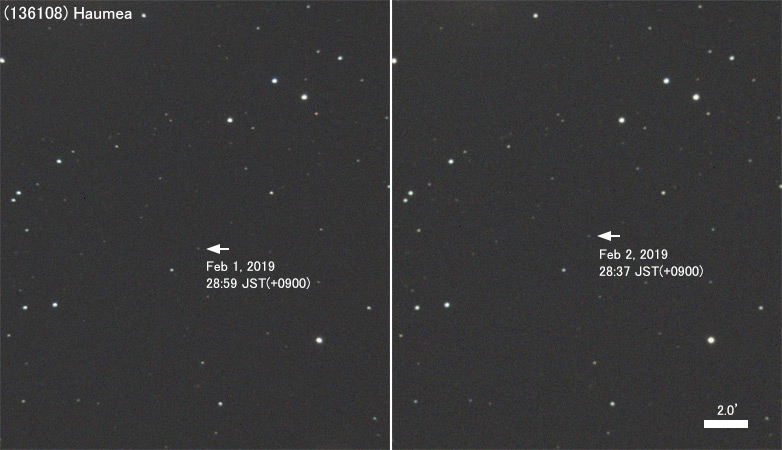| Date & Time: | Feb 1 2019, from 28:59 to 29:03 JST(+0900), 3min.×2shots |
| Feb 2 2019, from 28:37 to 28:40 JST(+0900), 3min.×2shots |
| Optical: | Meade 25cm(10") Schmidt-Cassegrain with conversion lens (f=1600mm, F6.3) |
| with BaaderPlanetarium Moon&Skyglow filter |
| Auto-guided with Meade LX200 Equatorial & Pictor 201XT |
| Digital Camera: | Canon EOS 6D (Remodeled) |
| Location: | Ooizumi, Hokuto city, Yamanashi pref. |
| (136108) Haumea |
|---|
| Semi-major axis | 43.032 au (6.438Bln km) |
|---|
| Perihelion distance | 34.537 au (5.167Bln km) |
|---|
| Aphelion distance | 51.526 au (7.708Bln km) |
|---|
| Orbital eccentricity | 0.197 |
|---|
| Orbital period | 282.29 yrs. |
|---|
| Parameters when photographed: |
| R.A. (2000.0) | 14h 19m 23.5s
→14h 19m 23.7s |
|---|
| Dec. (2000.0) | +16°04' 28"
→+16°05' 03" |
|---|
| Geocentric distance | 50.19 au (7.508Bln km) |
|---|
| Heliocentric distance | 50.44 au (7.546Bln km) |
|---|
| Magnitude | 17.2 |
|---|
Dwarf planet "Haumea" is one of Trans-Neptunian Objects (TNOs) classified in the Plutoid, discovered on Mar 7, 2003.
Haumea is revolving an elliptical orbit with a period of 282 years slightly outside of the Pluto (247 years in period);
the orbit tilts 28 degrees from the plane of the ecliptic.
A shape of Haumea has been presumed as an ellipsoid with axis lengths of 1000 to 2000 km; two tiny satellites had been discovered in 2005.
The dwarf planet was named after Goddess of fertility in the Hawaii islands, registered as the fourth Plutoid next to the Pluto, the Eris, and the Makemake in Sep. 2008.
This image has displayed by turning the celestial north direction upward.
When I photographed, Haumea had a visual brightness of 17.2th magnitude and was moving northward slowly in the southern region of Bootes.
Comparing two shots taken 24-hours apart, you can detect a Haumea's apparent movement of approximately 35 arc seconds.
|

